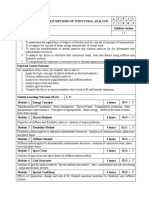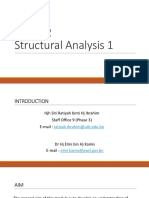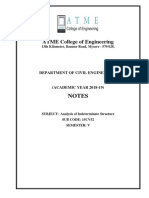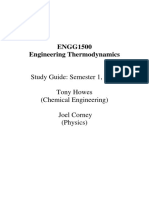0 ratings0% found this document useful (0 votes)
21 viewsStatics Syllabus
Statics Syllabus
Uploaded by
Anjana1. This document outlines the topics and structure of the MEE1002 Engineering Mechanics course, which covers fundamental principles of statics, analysis of structures, friction, properties of surfaces and solids, virtual work, kinematics, and energy and momentum methods.
2. The course consists of 30 hours of lectures over 7 modules and 15 hours of tutorials. Lectures will be videotaped and supplemented with physical and computer models as well as industry guest lectures.
3. Tutorials involve working through example problems individually and in teams, with homework and online quizzes/discussions also assigned. The goal is for students to gain skills in the listed subject learning outcomes centered around engineering analysis and problem solving.
Copyright:
© All Rights Reserved
Available Formats
Download as PDF, TXT or read online from Scribd
Statics Syllabus
Statics Syllabus
Uploaded by
Anjana0 ratings0% found this document useful (0 votes)
21 views2 pages1. This document outlines the topics and structure of the MEE1002 Engineering Mechanics course, which covers fundamental principles of statics, analysis of structures, friction, properties of surfaces and solids, virtual work, kinematics, and energy and momentum methods.
2. The course consists of 30 hours of lectures over 7 modules and 15 hours of tutorials. Lectures will be videotaped and supplemented with physical and computer models as well as industry guest lectures.
3. Tutorials involve working through example problems individually and in teams, with homework and online quizzes/discussions also assigned. The goal is for students to gain skills in the listed subject learning outcomes centered around engineering analysis and problem solving.
Original Description:
Psychology book
Original Title
statics syllabus
Copyright
© © All Rights Reserved
Available Formats
PDF, TXT or read online from Scribd
Share this document
Did you find this document useful?
Is this content inappropriate?
1. This document outlines the topics and structure of the MEE1002 Engineering Mechanics course, which covers fundamental principles of statics, analysis of structures, friction, properties of surfaces and solids, virtual work, kinematics, and energy and momentum methods.
2. The course consists of 30 hours of lectures over 7 modules and 15 hours of tutorials. Lectures will be videotaped and supplemented with physical and computer models as well as industry guest lectures.
3. Tutorials involve working through example problems individually and in teams, with homework and online quizzes/discussions also assigned. The goal is for students to gain skills in the listed subject learning outcomes centered around engineering analysis and problem solving.
Copyright:
© All Rights Reserved
Available Formats
Download as PDF, TXT or read online from Scribd
Download as pdf or txt
0 ratings0% found this document useful (0 votes)
21 views2 pagesStatics Syllabus
Statics Syllabus
Uploaded by
Anjana1. This document outlines the topics and structure of the MEE1002 Engineering Mechanics course, which covers fundamental principles of statics, analysis of structures, friction, properties of surfaces and solids, virtual work, kinematics, and energy and momentum methods.
2. The course consists of 30 hours of lectures over 7 modules and 15 hours of tutorials. Lectures will be videotaped and supplemented with physical and computer models as well as industry guest lectures.
3. Tutorials involve working through example problems individually and in teams, with homework and online quizzes/discussions also assigned. The goal is for students to gain skills in the listed subject learning outcomes centered around engineering analysis and problem solving.
Copyright:
© All Rights Reserved
Available Formats
Download as PDF, TXT or read online from Scribd
Download as pdf or txt
You are on page 1of 2
MEE1002 ENGINEERING MECHANICS L,T,P,J,C
Pre-Req: NIL 2, 1, 0,0,3
L
Module Topics SLO
Hrs
Basics of Statics: Fundamental Principles - Coplanar forces - Resolution
and Composition of forces and equilibrium of particles - Forces of a
1 particle in space - Equivalent system of forces - Principle of 6 1,2,5
transmissibility - Single equivalent force - Free body diagram -
Equilibrium of rigid bodies in two dimensions and three dimensions
Analysis of Structures: Types of supports and their reactions - Plane
2 trusses and frames - Analysis of forces by method of joints and method 4 1,2,5,6
of sections
Friction: Characteristics of dry friction – simple contact friction –
3 3 1,2,4, 14
Wedges and Ladder friction
Properties of Surfaces and Solids: Centroid - First moment of area –
Second moment of area – Moment and product of inertia of plane areas –
4 5 1,2,4
Transfer Theorems - Polar moment of inertia – Principal axes – Mass
moment of inertia
Virtual Work: Virtual work – Principle of virtual work – System of
5 connected rigid bodies – Degrees of freedom – Conservative forces – 4 1,2,4
Potential energy – Potential energy criteria for equilibrium.
Kinematics: Displacements, Velocity and Acceleration – Rectilinear
6 motion – Curvilinear motion – Tangential and Normal components – 4 1,2
Radial and Transverse components.
Energy and Momentum Methods: Principle of work and energy for a
particle and a rigid body in plane motion – Conservation of energy -
7 4 1,2,5
Principle of impulse and momentum for a particle and a rigid bodies in
plane motion – Conservation of momentum.
Total Lecture Hours 30
# Mode: Flipped Class Room, [Lecture to be videotaped], Use of physical and computer models to lecture, Visit to Industry and study the
thermal equipments, Min of 2 lectures by industry experts
Tutorial
Tutorial Class for Module 1 2
Tutorial Class for Module 2 2
Tutorial Class for Module 3 1
Tutorial Class for Module 4 3
Tutorial Class for Module 5 1,2,5
2
Tutorial Class for Module 6 2
Tutorial Class for Module 7 3
# A minimum of 3 problems to be worked out by students in every Tutorial Class. Another 5 problems per
Tutorial Class to be given as home work.
At least one open ended design problem to be given.
# Mode: Individual Exercises, Team Exercises, Online Quizzes, Online Discussion Forums
Total tutorial Hours15
Text Books
1. Beer, Johnston, Cornwell and Sanghi (2013) Vector Mechanics for Engineers: Statics and
Dynamics, 10th Edition, McGraw-Companies, Inc., New York.
Reference Books
1. Timoshenko. S, Young. D.H and Rao. J.V. (2007), Engineering Mechanics, 4th Edition, McGraw-
Companies, Inc., New York.
2. Irving H. Shames and Krishna Mohaba Rao. G (2009), Engineering Mechanics - Statics and
Dynamics, 4th Edition, Prentice-Hall of India Pvt. Ltd.
3. Meriam J.L and Kraige L.G. (2012) Engineering Mechanics, Volume I - Statics, Volume II -
Dynamics, 7th Edition, John Wiley & Sons, New York.
4. Tayal. A. K. (2010) Engineering Mechanics- Statics and Dynamics, Umesh Publications, New
Delhi.
You might also like
- Syllabus Phys 3 CHED New NormalDocument14 pagesSyllabus Phys 3 CHED New NormalJay-r P. MolaseNo ratings yet
- ACTD - Advanced Starship Design Bureau - Luna-Class SpecsDocument32 pagesACTD - Advanced Starship Design Bureau - Luna-Class SpecsJames Tiberius Henkel100% (1)
- MEE1002 Engineering-Mechanics TH 1 AC37Document2 pagesMEE1002 Engineering-Mechanics TH 1 AC37DiVik BhargAvaNo ratings yet
- CLE2003 Structural AnalysisDocument1 pageCLE2003 Structural AnalysisDESIGN CONSULTANTNo ratings yet
- Sylabus Kinematics and Dynamics of Machinery CDIO - 2017Document5 pagesSylabus Kinematics and Dynamics of Machinery CDIO - 2017minhNo ratings yet
- Mee1002 Engineering-Mechanics LT 1.0 1 Mee1002Document2 pagesMee1002 Engineering-Mechanics LT 1.0 1 Mee1002krishanpurohit3No ratings yet
- EIM 116 Course Outline FinalDocument4 pagesEIM 116 Course Outline FinalTAKUDZWA TERRENCE MAREGERENo ratings yet
- Applied MathematicsIIDocument3 pagesApplied MathematicsIIKeshav KumarNo ratings yet
- Cle2002 Strength-Of-Materials Eth 1.1 47 Cle2002Document2 pagesCle2002 Strength-Of-Materials Eth 1.1 47 Cle2002Yash ManeNo ratings yet
- 5th Sem Scheme Mechanical EngineeringDocument26 pages5th Sem Scheme Mechanical EngineeringYogesh MokaddamNo ratings yet
- Course Handout: Course Title Course No(s) Credit Units Credit ModelDocument10 pagesCourse Handout: Course Title Course No(s) Credit Units Credit ModelUmesh BhadaleNo ratings yet
- BE Comp 4th Sem Syallabus Compiled by U0 - 240422 - 115845 - RemovedDocument17 pagesBE Comp 4th Sem Syallabus Compiled by U0 - 240422 - 115845 - Removedanjalluitel3No ratings yet
- ME 1222 Applied Mechanics - Module DescriptorDocument3 pagesME 1222 Applied Mechanics - Module Descriptor40-eng-0003No ratings yet
- Cle5010 Matrix-methods-Of-structural-Analysis TH 1.1 47 Cle5010Document2 pagesCle5010 Matrix-methods-Of-structural-Analysis TH 1.1 47 Cle5010Aashini Enid ErnestinaNo ratings yet
- De ZG611 Course HandoutDocument11 pagesDe ZG611 Course HandoutKishore MNo ratings yet
- Fem PDFDocument3 pagesFem PDFJavedNo ratings yet
- FEA NEW Lession PlanDocument4 pagesFEA NEW Lession Planbalusharma1212No ratings yet
- MEE2004 Mechanics-Of-Machines ETH 1.1 AC40Document3 pagesMEE2004 Mechanics-Of-Machines ETH 1.1 AC40orionNo ratings yet
- Handout_MATH_F471_2_2024Document2 pagesHandout_MATH_F471_2_2024VenkateswaraNo ratings yet
- Syllabus of Frist Semester: Applied Mechanics I (Statics) Beg156CiDocument10 pagesSyllabus of Frist Semester: Applied Mechanics I (Statics) Beg156CiSunil MandalNo ratings yet
- Structural Analysis 1 (Intro)Document8 pagesStructural Analysis 1 (Intro)Muhammad HaziqNo ratings yet
- MEC 1391 MECH 1301 Sem2-2016-17Document6 pagesMEC 1391 MECH 1301 Sem2-2016-17Mad lolNo ratings yet
- De ZG611 Course HandoutDocument7 pagesDe ZG611 Course HandoutpanyamnrNo ratings yet
- Power Distribution and Utilization: 1. Course CodeDocument3 pagesPower Distribution and Utilization: 1. Course CodeSakhawat AliNo ratings yet
- AE SyllabusDocument158 pagesAE Syllabusuzma takkalkiNo ratings yet
- Flat Spiral SpringsDocument2 pagesFlat Spiral SpringsBharani DaranNo ratings yet
- Course Details-Mechanical VibrationDocument6 pagesCourse Details-Mechanical Vibrationbereket gNo ratings yet
- Fedda Phys 311Document4 pagesFedda Phys 311gugu FilipeNo ratings yet
- BE Comp 4th Sem Syallabus Compiled by U0....... 1 1Document32 pagesBE Comp 4th Sem Syallabus Compiled by U0....... 1 1Subhash RautNo ratings yet
- MTH 250 Applied MathematicsDocument4 pagesMTH 250 Applied MathematicsSuresh RawatNo ratings yet
- Mechanical Engineering III Sem SyllabusDocument19 pagesMechanical Engineering III Sem Syllabussaurabh1116No ratings yet
- Me 6603Document162 pagesMe 6603Anandu ANo ratings yet
- TOM SyllabusDocument3 pagesTOM SyllabuschupchapNo ratings yet
- App Maths-1 PDFDocument4 pagesApp Maths-1 PDFVaibhav AgarwalNo ratings yet
- Mat1001 Fundamentals-Of-Mathematics TH 1.1 47 Mat1001Document2 pagesMat1001 Fundamentals-Of-Mathematics TH 1.1 47 Mat1001Tanay KuchloryaNo ratings yet
- TCET FE Applied Mathematics - I (2018-2019)Document196 pagesTCET FE Applied Mathematics - I (2018-2019)Kevin100% (1)
- 334C6CDocument3 pages334C6CHariharanNo ratings yet
- At The Completion of The CourseDocument2 pagesAt The Completion of The Courseoday albuthbahakNo ratings yet
- 15CV52 NOTES Ghu MkiDocument73 pages15CV52 NOTES Ghu MkiRavishankar HobannaNo ratings yet
- MAT3004 SyllabusDocument2 pagesMAT3004 SyllabusAlokNo ratings yet
- Multibody Dynamics: Co-Requisite: Prerequisite: Data Book / Codes/Standards Course Category Course Designed by ApprovalDocument4 pagesMultibody Dynamics: Co-Requisite: Prerequisite: Data Book / Codes/Standards Course Category Course Designed by ApprovalJanardhan VustepalliNo ratings yet
- TCET FE EM Resource Book (2018-19)Document375 pagesTCET FE EM Resource Book (2018-19)KevinNo ratings yet
- Theory of Structure-IDocument2 pagesTheory of Structure-IAnil MarsaniNo ratings yet
- Finite Element Method: Dr. Jagadish. T, 1Document8 pagesFinite Element Method: Dr. Jagadish. T, 1rasprasadNo ratings yet
- EE 452-Power Electronics-Nauman Ahmad ZaffarDocument4 pagesEE 452-Power Electronics-Nauman Ahmad ZaffarSheikh AsherNo ratings yet
- EM MOD1-Ktunotes - inDocument37 pagesEM MOD1-Ktunotes - inIndra Pratap SengarNo ratings yet
- 124E2ADocument2 pages124E2AParthiban DevendiranNo ratings yet
- S - Y - B Tech - Mech - Sem-IIDocument17 pagesS - Y - B Tech - Mech - Sem-IIakshatraj875No ratings yet
- Operation Reaserch ConceptDocument2 pagesOperation Reaserch ConceptSundaram JegatheesanNo ratings yet
- DOM Course Design Policy 2022Document12 pagesDOM Course Design Policy 2022Savio B CardosoNo ratings yet
- Applied MathematicsDocument4 pagesApplied MathematicsKamalnath GNo ratings yet
- Civil EngineeringDocument29 pagesCivil Engineeringalyfaiz69No ratings yet
- ENGG1500 Study Guide S1 2018 PDFDocument137 pagesENGG1500 Study Guide S1 2018 PDFKatty TsaiNo ratings yet
- SYLLDocument2 pagesSYLLaksdafNo ratings yet
- Mat3004 Applied-linear-Algebra TH 1.1 47 Mat3004Document2 pagesMat3004 Applied-linear-Algebra TH 1.1 47 Mat3004Garvit GuptaNo ratings yet
- Syllabus PDFDocument3 pagesSyllabus PDFSaketh SentinalNo ratings yet
- OBE-2: Syllabus: Laplace TransformDocument4 pagesOBE-2: Syllabus: Laplace TransformHaziq PazliNo ratings yet
- SyllabusDocument4 pagesSyllabusSHAAD SARWAR MOHAMMEDNo ratings yet
- 26 03 SLDocument16 pages26 03 SLDeepak BagriNo ratings yet
- MAT565 SOW MAC 2024 (2)Document4 pagesMAT565 SOW MAC 2024 (2)gjqrsdk8t7No ratings yet
- Teaching Scheme:: (An Autonomous Institute of Govt. of Maharashtra)Document43 pagesTeaching Scheme:: (An Autonomous Institute of Govt. of Maharashtra)Prathamesh PatilNo ratings yet
- SHM - Practice Sheet SolutionDocument41 pagesSHM - Practice Sheet SolutionDeeksha S.RNo ratings yet
- Experiment 4 Friction) 1Document5 pagesExperiment 4 Friction) 1bokondiNo ratings yet
- Fluid Mechanics Chapter 4Document12 pagesFluid Mechanics Chapter 4Ricky MakNo ratings yet
- New Kinematics Some SolutionDocument3 pagesNew Kinematics Some Solutionkua566ontNo ratings yet
- Chapter 2 - Electrostatic Potential - Capacitance (Student Copy)Document40 pagesChapter 2 - Electrostatic Potential - Capacitance (Student Copy)tanmayrkumbleNo ratings yet
- Thermodynamics and Climate Change - MITDocument258 pagesThermodynamics and Climate Change - MITblabaubNo ratings yet
- Arijit Das Chapter-2 Innovative Method For The Prediction of Bond Order Without MOTDocument11 pagesArijit Das Chapter-2 Innovative Method For The Prediction of Bond Order Without MOTDrArijit DasNo ratings yet
- Ferromagnetism Weiss Theory Domain ModelDocument10 pagesFerromagnetism Weiss Theory Domain Modellittleartz2024No ratings yet
- 5 Nuclear Physics Revision 5.2 Radioactivity - IGCSE Physics - Chris Gozzard PhysicsDocument2 pages5 Nuclear Physics Revision 5.2 Radioactivity - IGCSE Physics - Chris Gozzard PhysicsDAVID ESCALANTE GILNo ratings yet
- Coulomb LawDocument2 pagesCoulomb LawJanelyn GarinNo ratings yet
- 1432506514-EMF Full Question BankDocument3 pages1432506514-EMF Full Question BankOza JayNo ratings yet
- Projectile MotionDocument45 pagesProjectile MotiondynamicranjanNo ratings yet
- Chapter 1 - General Principles: ObjectivesDocument5 pagesChapter 1 - General Principles: ObjectivesRhey LuceroNo ratings yet
- Maths Project 2Document8 pagesMaths Project 2Raj MallickNo ratings yet
- LrhmetfDocument59 pagesLrhmetfkondakov.artemNo ratings yet
- Cam Design Handbook - H. Rothbart (2004) WW Pages Pressure AngleDocument3 pagesCam Design Handbook - H. Rothbart (2004) WW Pages Pressure Angleksh.sahNo ratings yet
- Applied Mathematics III PDFDocument148 pagesApplied Mathematics III PDFزكرياء بنحيرت86% (7)
- PHY (1)Document4 pagesPHY (1)shriya ShrivastavNo ratings yet
- Applied Mechanics-Statics III PDFDocument24 pagesApplied Mechanics-Statics III PDFTasha ANo ratings yet
- Rheology of Fresh Cement and ConcreteDocument70 pagesRheology of Fresh Cement and ConcretePHD FlopperNo ratings yet
- Physics Chapter 25Document57 pagesPhysics Chapter 25kk.sheela243No ratings yet
- HW NuclearDocument4 pagesHW Nuclearhemnphysic91No ratings yet
- Download Full Modern X ray analysis on single crystals a practical guide 2nd edition. Edition Luger PDF All ChaptersDocument81 pagesDownload Full Modern X ray analysis on single crystals a practical guide 2nd edition. Edition Luger PDF All Chapterssmebypalui100% (2)
- (PHYSCI) Quarterly ExaminationDocument2 pages(PHYSCI) Quarterly ExaminationTLGA Emmanuel PotoyNo ratings yet
- 14a Plancks Constant Photo Electric EffectDocument7 pages14a Plancks Constant Photo Electric EffectSAKSHI SINGHNo ratings yet
- Sri Chaitanya: IIT Academy.,IndiaDocument18 pagesSri Chaitanya: IIT Academy.,IndianandagtNo ratings yet
- Physics: Kinematics - Describing MotionDocument25 pagesPhysics: Kinematics - Describing MotiontonyNo ratings yet
- Final Fomrula SheetDocument2 pagesFinal Fomrula Sheetraindashy2No ratings yet

























































































